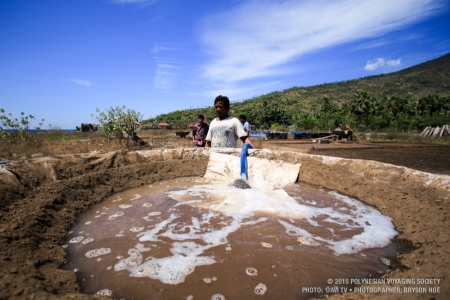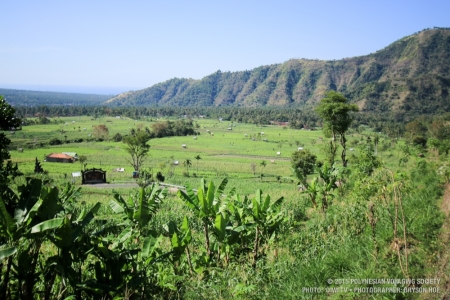
Crew Blog | Bryson Hoe: Amed Salt Farming
- Posted on 12 Aug 2015
- In Crew Blogs, Malama Honua, Malama Honua Selects, Newsletter, Teachers
 Written by Bryson Hoe.
Written by Bryson Hoe.Driving along the eastern shores of Bali, the sights and sounds of the city give way to a single lane road that takes us past valleys of terraced rice fields and on to Amed and Karangasem.
We are welcomed by village members with a simple ceremony and offered small rice snacks before exploring the reefs that have made this once isolated community an increasingly popular destination for tourists. Upon returning to shore, we are given more food – a common occurrence during our visit in Bali that reflects the warmth and generosity of the people – before engaging in conversation around shared issues such as tourism, environmental stewardship, and cultural preservation.On the back of a moped driven by one of the village leaders, I am fortunate to visit the nearby salt beds. Surrounded by traditional homes with a clear view of Mount Agung rising in the distance, the ocean-front site is unassuming when first approached. The only clear indication of the salt beds are structures that resemble giant coffee filters at the center of four quadrants, quietly tended to by several families.
 During the salt-producing season that runs from July to December, the shallow fields are first smoothed then filled with salt water. Over three days, the water evaporates leaving behind salt-laden soil. This soil is then broken up and put in the large cone structure that acts as a filter. Additional sea water is added to the soil, and an underground reservoir collects the extremely salty water. The water is then scooped into coconut logs to dry out for an additional ten days, leaving behind large salt granules. This labor-intensive process is rotated across the four fields each day. The salt is then stored in a warehouse for 6 months before being sold.
During the salt-producing season that runs from July to December, the shallow fields are first smoothed then filled with salt water. Over three days, the water evaporates leaving behind salt-laden soil. This soil is then broken up and put in the large cone structure that acts as a filter. Additional sea water is added to the soil, and an underground reservoir collects the extremely salty water. The water is then scooped into coconut logs to dry out for an additional ten days, leaving behind large salt granules. This labor-intensive process is rotated across the four fields each day. The salt is then stored in a warehouse for 6 months before being sold.
The village elder explains that salt has been farmed the same way in Amed and other communities for hundreds of years. Unfortunately, like other parts of Bali, development and higher wages in the tourism industry threaten this traditional practice that fewer families continue.
 Each coconut log can last up to 30 years if properly maintained. However, buying new logs is prohibitively expensive, and farmers have turned to drying out the salt in shallow beds lined with plastic. All of the farmers agree that this non-traditional alternative compromises the quality of the salt and would rather use the coconut logs.
Each coconut log can last up to 30 years if properly maintained. However, buying new logs is prohibitively expensive, and farmers have turned to drying out the salt in shallow beds lined with plastic. All of the farmers agree that this non-traditional alternative compromises the quality of the salt and would rather use the coconut logs.
To protect this practice, the village has sought to create a trademark for salt produced in the region that emphasizes its high quality. Additionally, an information center is being created that will educate visitors about the unique salt-farming history of the region.
As we depart, we are gifted with several bags of sea salt that will be put to good use on board Hokulea so that we may remember our time here.
Please help keep us sailing for future generations. All contributions make a difference for our voyage. Mahalo nui loa!












